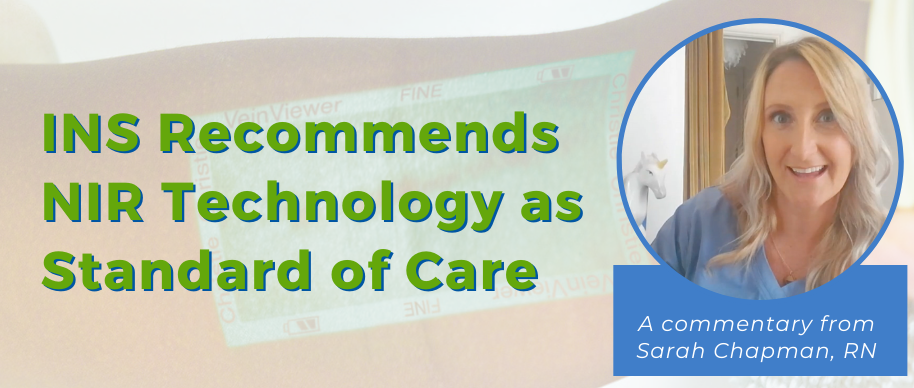The Infusion Nurses Society (INS) recently published their latest Infusion Therapy Standards of Practice and  recommends vascular access devices with near-infrared (NIR) technology as a standard of care! Read on for a commentary on these recommendations from Sarah Chapman, RN
recommends vascular access devices with near-infrared (NIR) technology as a standard of care! Read on for a commentary on these recommendations from Sarah Chapman, RN
INS Guidelines 2021 – A Commentary from Sarah Champan, RN
When I opened my fresh copy of the 2021 INS Infusion Therapy Standards of Practice, I was both nervous, and excited. Advancement had been made in the field of near-infrared (NIR) and vascular visualization, but what would the INS have to say about this?
Over the course of my 20-year nursing career, I hold specialties in neonatology, pediatrics, global health, and infusion care. In 2007, I began the challenging work of clinically verifying, educating, and proving the efficacy of the first-ever near infrared vascular device, called VeinViewer®. (now Christie VeinViewer®) Alongside the original inventor and an innovative team, we collectively introduced the world to better patient outcomes with our original green technology. We ran clinical trials, demonstrated the devices all over the globe, worked 24-hour support, conducted symposiums, congresses, conferences, we fought hospital budgets, nay-sayers, and trepidatious procurement committees. Other “copy-cat” devices would eventually enter the market, but none could offer the accuracy and venous capacity that the VeinViewer® could. And so, began the 14-year journey of NIR becoming a Standard of Care in Vascular Access.
infusion care. In 2007, I began the challenging work of clinically verifying, educating, and proving the efficacy of the first-ever near infrared vascular device, called VeinViewer®. (now Christie VeinViewer®) Alongside the original inventor and an innovative team, we collectively introduced the world to better patient outcomes with our original green technology. We ran clinical trials, demonstrated the devices all over the globe, worked 24-hour support, conducted symposiums, congresses, conferences, we fought hospital budgets, nay-sayers, and trepidatious procurement committees. Other “copy-cat” devices would eventually enter the market, but none could offer the accuracy and venous capacity that the VeinViewer® could. And so, began the 14-year journey of NIR becoming a Standard of Care in Vascular Access.
 For anyone who knows me, you know that I have a hard time containing excitement…just ask my colleagues. So, when I read the 2021 INS Standards and saw that near-infrared has now entered the category of a proven technology and a definitive recommended practice (Section Four; 22. “Vascular Visualization”) I leapt out of my chair and shouted, “WE FINALLY DID IT!!” We have arrived at the apex of collective hard work and changed the course of medical history. Healthcare institutions, spanning the globe, will be compelled to take an inventory of their current vascular practices, and move into the future with near-infrared technology. I’ve often struggled with the long adoption of certain technologies in healthcare. Why wouldn’t an organization readily use an obvious tool that helps patients? Inflict less pain on our fellow humanity? Lessen pediatric procedural trauma? No one, likes getting “stuck” by needles, let alone, multiple needles. And now, having clear guidelines surrounding near-infrared and its’ multiple areas of patient use, we (Christie Medical Holdings), can begin the next phase of changing the vascular landscape.
For anyone who knows me, you know that I have a hard time containing excitement…just ask my colleagues. So, when I read the 2021 INS Standards and saw that near-infrared has now entered the category of a proven technology and a definitive recommended practice (Section Four; 22. “Vascular Visualization”) I leapt out of my chair and shouted, “WE FINALLY DID IT!!” We have arrived at the apex of collective hard work and changed the course of medical history. Healthcare institutions, spanning the globe, will be compelled to take an inventory of their current vascular practices, and move into the future with near-infrared technology. I’ve often struggled with the long adoption of certain technologies in healthcare. Why wouldn’t an organization readily use an obvious tool that helps patients? Inflict less pain on our fellow humanity? Lessen pediatric procedural trauma? No one, likes getting “stuck” by needles, let alone, multiple needles. And now, having clear guidelines surrounding near-infrared and its’ multiple areas of patient use, we (Christie Medical Holdings), can begin the next phase of changing the vascular landscape.
The 2021 INS Standards expand upon the use of NIR beyond being a tool for difficult venous access patients (DIVA), as compared to previous Standard revisions. The main guidelines surrounding vascular access include:
- The pediatric patient and improving insertion success (Section One; 2 (A).3)
- The emergency department and meeting emergent venipuncture needs to increase patient safety (ie: VeinViewer®) (Section One; 4 (B).5)
- Practicing noninvasive vascular training to improve competencies and outcomes (Section One; 5 (K).5)
- Utilizing vascular visualization as an impetus to create a full patient vascular profile; also known as pre-access planning. (Section Four; 22.1-(A).1-7)
- Locating peripheral sites and decrease procedure time for PIVC insertion. (Section Four; 22.1 (D).1)
- Performing a comprehensive pre-assessment of all venous sites and make a more informed decision about vein selection. Including the discovery and assessment of bifurcations, tortuosity, non-visible veins, and location of venous valves. (Section Four; 22.1 (D).2)
- Increasing first-time insertion success and decreasing procedural time for all patients, including neonates (Section Four; 22.1 (D).2)
- Measuring the catheter-to-vessel ratio prior to VAD insertion (Section Four; 22.1 (E))
- Assessing clinician competencies in assessments of vessels, size, depth, location, potential complications, in the use of vascular visualization (ie: VeinViewer®) (Section Four; 22.1 (J)
- Increasing success for DIVA patients (Section Five; II (B).2, & 34.1 (D)
- Finding and assessing deeper veins for long PIVC’s (Section Five; III (A).1)
- Identifying and selecting veins for midline catheter insertion (Section Five; “Practice Recommendations”; I (A).3)
- Reducing pain and improving patient needle experience (Section Five; 32.1 (A-B)
- Identifying veins and tourniquet necessity for venipuncture (Section Six; 44.1 (E).7)
The Christie VeinViewer® affords full alignment with the new multi-disciplined Guidelines, and comprehensively executes all recommendations for the above-mentioned sections. Even as I write this, my nurses’ heart is full of hope and promise for our patients we serve. Now that VeinViewer® is closer to compulsory as ever before, our medical community will inflict less pain, treat faster, save money, and heal people more efficiently.
As we enter this new era of technology and modernized vascular access, Christie will be requiring healthcare systems to look at VeinViewer® as an obligatory tool for success. There are no more excuses. Your choices impact your outcomes!
Sarah attended the INS 2021 Standards of Practice Virtual Education Conference! Check out Part 2 by clicking here!

